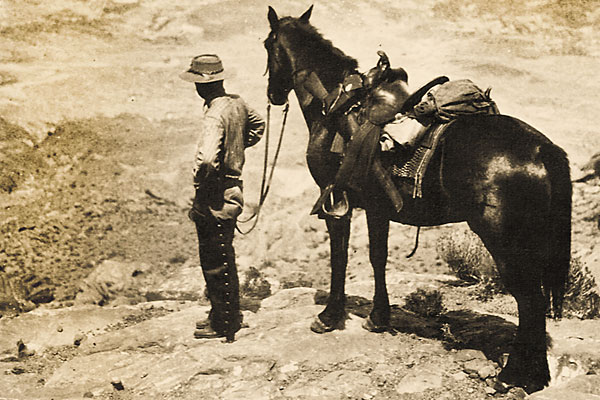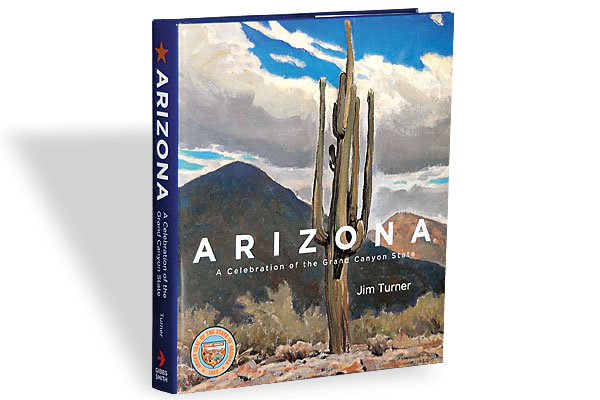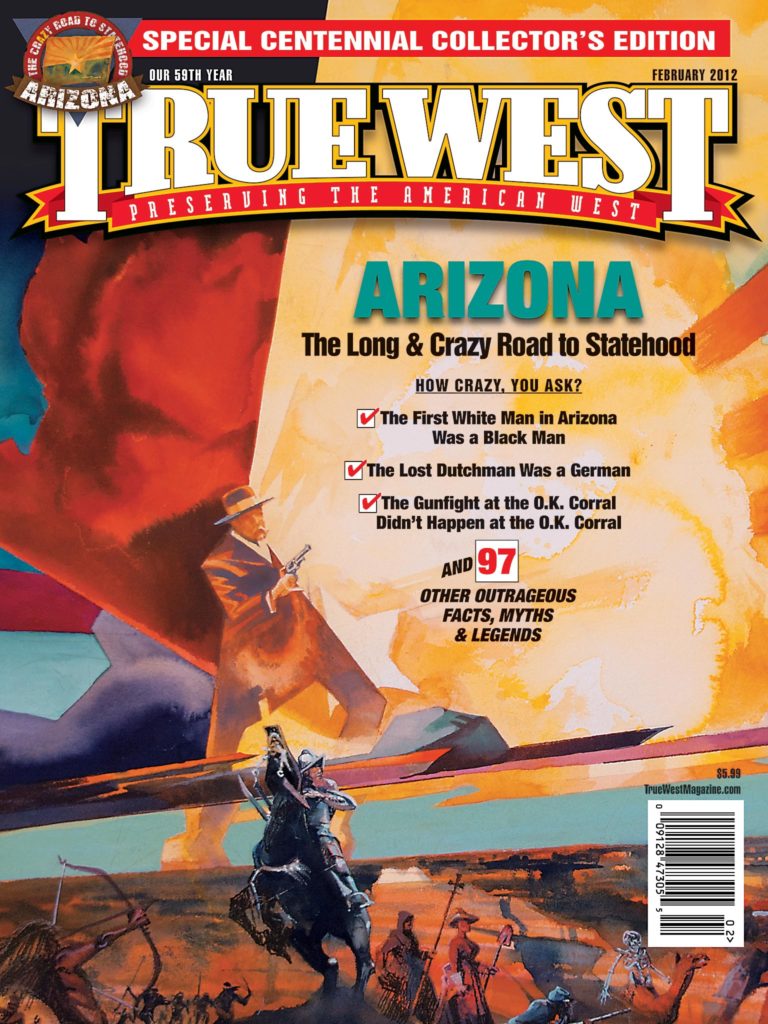 In 1906, novelist Zane Grey visited the Arizona Territory for the first time.
In 1906, novelist Zane Grey visited the Arizona Territory for the first time.
The Southwestern landscape fired his imagination; after a few return trips, he began writing Riders of the Purple Sage, published by Harper and Brothers in 1912. It racked up blockbuster sales to become one of the most successful novels of the American West. By the early 1920s, Grey’s books were outsold only by McGuffey’s Readers for young children and the Bible.
The huge success of Riders of the Purple Sage caught the eye of producer William Fox, founder of the Fox Film Corporation, ancestor of today’s 20th Century Fox. In 1916, he paid Grey $2,500 apiece for worldwide photoplay rights for the book and for its sequel, The Rainbow Trail. Fox released silent film adaptations of both films in 1918 and followed up the next year with versions of Grey’s The Last of the Duanes and The Lone Star Ranger.
By 1918, Grey had recognized a lot of money could be made adapting his stories to the movies, so he formed Zane Grey Pictures, with partner Benjamin B. Hampton. But after releasing seven films—five of which featured Hampton’s wife, a-ctress Claire Adams—Grey bought out Hampton’s stake in late 1922, then turned around and sold the company outright to Famous Players–Lasky. It was a good deal for both sides: Grey would be paid $20,000 for a seven-year option on each title, with a share in the picture’s profits; in return, the studio could prominently promote Grey’s name on its Westerns, which would help ensure big box-office returns.
Famous Players–Lasky would release at least two, and as many as four, adaptations of Grey stories each year through 1928. Lavishly produced at $125,000 apiece, the Zane Grey series proved to be the most popular Westerns Hollywood released during this period. By 1940, well into the sound era, the studio would release 53 films based on Grey’s stories.
Since Grey believed the land he described in his writing was a vital element of his work, he made sure his deal with Lasky required that at least the first three films would be made in Arizona. It was a rare request at the time. According to statistics published in the 1924 Film Daily Year Book, only four percent of U.S. films were shot outside Los Angeles and New York that year.
Reporting on the Grey/Famous Players–Lasky deal in January 1923, The New York Times noted that Grey would “collaborate actively” on the “picturization” of his stories. Three months later, the paper reported Grey’s visit to New York to arrange the filming of the first of his novels. To the Last Man was to be filmed at Tonto Basin, about 60 miles northeast of Phoenix, which the paper described as “one of the most difficult spots of access in the entire United States.”
Victor Fleming directed the project. He would leave his lasting mark on movie history years later, in 1939, when he directed both Gone with the Wind and The Wizard of Oz. When To the Last Man hit theaters on September 23, 1923, Fleming and crew were in Oak Creek Canyon to film Grey’s The Call of the Canyon.
While the 1923 version of To the Last Man is lost (perhaps mercifully; The New York Times described it as “one of those pictures that give one a fit of yawning”), snippets of its footage from Payson, Arizona, survive. Paramount reused some outdoor scenes in a 1933 talkie remake, a budget measure repeated from the 1932 sound remake of The Heritage of the Desert. Both 1930s films were early directorial efforts of Henry Hathaway, the prop man on To the Last Man and The Call of the Canyon; he’d go on to direct noir classics in the 1940s and John Wayne’s Oscar-winning performance in 1969’s True Grit.
Unfortunately, because the silent version was never remade, most of the scenes photographed in Oak Creek Canyon for The Call of the Canyon are lost forever (a few fragments were uncovered in 2010).
The Call of Oak Creek Canyon
When did Zane Grey first lay eyes on Oak Creek Canyon?
Local legends have claimed that he actually wrote The Call of the Canyon there or, alternatively, at a hotel in Flagstaff, but in Zane Grey: A Biography, Frank Gruber—who had access to Grey’s records, diaries and journals—found Grey actually began the story in 1921 at his home on Catalina Island in southern California, worked on it in Oregon and completed it before departing on a trip to Colorado.
But Grey certainly knew the local view. Vivid descriptions of Oak Creek Canyon—“The very forest-fringed earth seemed to have opened into a deep abyss, ribbed by red rock walls and choked by steep mats of green timber”—filled his pages. A January 1924 book review of The Call of the Canyon in The New York Times noted: “Here scenery does more than fill space. Potent in its influence upon the people of the story, it is a character in itself: the leading character, indeed. The wild, lonely, fearfully beautiful Arizona desert has never been better done.”
Flagstaff rancher and wilderness guide Lee Doyle was the man who arranged Grey’s first trip into Oak Creek Canyon. He, more than anyone else, was responsible for Sedona—and northern Arizona’s—movie legacy.
During an April 1911 visit to Arizona, Grey had hired Lee’s father, Al Doyle, as his guide to the Indian reservations in the northern part of the territory. A resident of the frontier since 1866, Detroit-born Al worked as a cowboy, buffalo hunter and rancher, and his tales of the West provided inspiration for much of Grey’s writing. Al’s campfire reminiscences of his days as a teamster and Indian fighter during construction of the Union Pacific Railroad provided Grey the inspiration for his novel The U.P. Trail, the biggest-selling American book of 1918. In the book’s dedication, Grey wrote, “I have Doyle’s stories of sudden death and terrible lust and alluring gold—unforgettable stories; and it seems as though all the labor, violence and havoc of those years have become embodied in my imagination.”
Grey returned numerous times to northern Arizona over the next decade for more excursions with Al and Lee (born in a log cabin south of Flagstaff on June 12, 1881) as his guides. They became close friends.
After Al’s death in November 1921, Grey and Lee grew even closer, so Grey naturally involved Lee in the productions of movies made from his stories. He insisted Famous Players–Lasky hire Lee for his wide-ranging knowledge of the area and of the West.
Lee was a “typical westerner of many occupations—cowboy, rider, rancher, cattleman,” as Grey described him in his 1922 nonfiction book, Tales of Lonely Trails. “He was small, thin, supple, quick, tough and strong. He had a bronzed face, always chapped, a hooked nose, gray-blue eyes like his father’s, sharp and keen.”
Grey also portrayed a thinly disguised Lee as one of the principal characters of “On Location,” a short story about a fictional movie crew at work in Arizona, which was first published in the 1979 anthology The Camp Robber and Other Stories. The local location scout is Lee Hornell (described as a slim, hawk-nosed and red-faced Arizonian), who worked with a “Meteor Pictures” crew in northern Arizona. Although the story does not take place in Oak Creek Canyon, it does describe a dangerous horse stunt staged there for the movie.
Beginning with The Call of the Canyon, Lee was the location manager for virtually every movie filmed in the Sedona/northern Arizona area well into the mid-1950s, actively lobbying the studios to bring their picture work to the state, and providing them with technical expertise, location scouting, transportation and supplies. (In 1935, the Flagstaff newspaper, The Coconino Sun, would declare Doyle had “done far more than any other man to publicize our wonderful scenery and climate.”)
The Vanishing American
In December 1922, less than a year before he sold the film rights to Call of the Canyon, Grey met with Jesse L. Lasky in and around Flagstaff, ostensibly to scout locations for The Vanishing American, his story about the plight of contemporary American Indians, which had debuted as a serial in The Ladies’ Home Journal the previous month and would run in monthly installments through April 1923.
Grey desired to show Indians as humans rather than as the dimestore sociopaths they were portrayed as so often in the popular culture. He addressed tough themes like racism, miscegenation and religious hypocrisy.
He had been working on the project for at least a decade. Then, on June 22, 1922, he recorded in his diary: “I have finished The Vanishing American—my novel on the Indian…. In April I took a hard and trying trip across the Painted Desert, Paiute Canyon, and Uplands country to Nonnezoshe [the Navajo name for Rainbow Bridge]. It was most productive. On May 5 I began writing, and I finished the novel June 8 with only two breaks in my continuous work.”
During the film production of Call of the Canyon, Grey submitted to Harper and Brothers at least three revised Vanishing American manuscripts that incorporated changes suggested by his editors. Disgusted by it all, he wrote in a March 24, 1924, letter to his wife, Dolly, that he considered withdrawing the book, except he knew it was slated to appear simultaneously with the movie. Grey grudgingly played along because he knew the impact a successful movie tie-in would have on his book sales.
Yet the studio’s and publisher’s tampering with The Vanishing American remained a sore point for Grey. In his preface to the 1984 unexpurgated edition of the novel, Dr. Loren Grey included the text of a letter written by his deeply disenchanted father to Hoyns and William Briggs, another of his Harper and Brothers editors, on May 25, 1925:
“As to the motion picture, I have eliminated entirely the missionary element. This I was forced to do by the influence brought to bear upon the Will Hays office, by missionary powers.
“I just returned from Arizona, where I went to confer with Hubbard and Griffith. While there I got the proper angle on who was back of the propaganda. These missionaries would not stop at anything. My personal Arizona men warned me that it was actually not safe for me to go on the reservation. There are hirelings, and even some missionaries especially, who might shoot me from some canyon wall.
“This is the first time in my life that I have been driven away from the truth, from honor and ideals, and in this case, from telling the world of the tragedy of the Indian. It is a melancholy thing. I wonder what effect it will have upon me.”
In a New York Times article the following September, Lasky sidestepped the difference between The Ladies’ Home Journal version of Vanishing American and the movie version, claiming his movie originated when he and Lucien Hubbard had traveled with Grey through Arizona three years earlier (actually two years previously).
Lasky recalled, “We spent two months in this wild beautiful country in northern Arizona, sharing some of the hardships and privations of pioneer life, going a day without water for either ourselves or our horses, accepting the hospitality of Indians and learning to love it all. One of those Arizona sunsets will make even a native Californian pause in his praise of the golden state. It was during this trip that we conceived the idea of producing The Vanishing American and it was decided that the best man to write such a story was our host. Grey was enthusiastic, and immediately after our return to civilization he put everything to one side to start the story. We were well aware that it would cost a tremendous amount of effort, but we remained keen about it.”
Unfortunately, Lasky’s reinvented version of the film’s genesis is the one most sources have reported as fact.
So what was Grey’s opinion of the film version of Vanishing American? If you can believe a “tribute” credited to him by Famous Players–Lasky in the film’s souvenir program, he loved it: “The picture
is greater than the story. What more can an author say? Words, no matter how skilfully [sic] assembled, could never match the gorgeous beauty of the scenes that unfolded before me this morning.”
No matter what Grey’s true feelings were, The Vanishing American was one of 1925’s biggest hits. Ralph Allen, manager of the Imperial Theater in Long Beach, California, giddily described it to the Long Beach Press-Telegram as a “sensation,” with 9,000 patrons buying tickets to see it in his theater in four days.
Zane Grey’s Twilight
Between 1923-28, the now renamed Paramount Famous Lasky Corporation released almost a dozen Zane Grey films made at Arizona locations, including The Light of Western Stars and Code of the West (both 1925), The Last Frontier (1926), Drums of the Desert (1927, filmed at the Gap and Lees Ferry), Under the Tonto Rim (1928), The Water Hole (1928, filmed at Kayenta, Monument Valley and Navajo National Monument) and Avalanche (1928, Flagstaff).
At least one additional Arizona feature was planned but never made. In December 1924, Grey and a crew headed by cameraman Bert Glennon photographed a failed attempt to drive thousands of deer into the Grand Canyon with the idea of building an original screen story around the footage. But after shooting Sunset Pass in fall 1928 at Tuba City, Coal Canyon and Blue Canyon, the studio decided to film its Zane Grey productions in California and began to regularly change the author’s plots and characters.
The movie business itself had changed. When Lasky agreed to film at the locations Grey wrote about, he hadn’t foreseen how technological innovations, economic conditions and changing audience tastes would turn the movie business upside down. For Paramount, as with every other studio in Hollywood, costs skyrocketed as it grappled with the challenges of making talking films outdoors.
None of this sat well with Grey, who, as early as October 1927, began to air his grievances against Hollywood. Speaking to reporters in Phoenix after a hunting trip in Tonto Basin, where Paramount was filming Under the Tonto Rim, he grumbled, “I will not say that all of the people in the motion picture industry are crooks, but I will say that all the crooks in Hollywood are in the motion picture industry. Story pirates,” he continued, cause the best known of writers “to be on their toes all the time.”
But by 1930, with Hollywood looking warily upon Westerns and his box-office clout diminished, Grey was finally forced to abandon his demand that his stories be filmed at the locations he wrote about.
The edited excerpt is from Arizona’s Little Hollywood: Sedona and Northern Arizona’s Forgotten Film History, 1923-1973 by Joe McNeill. Visit ArizonasLittleHollywood.com or your local bookstore to purchase a copy.




